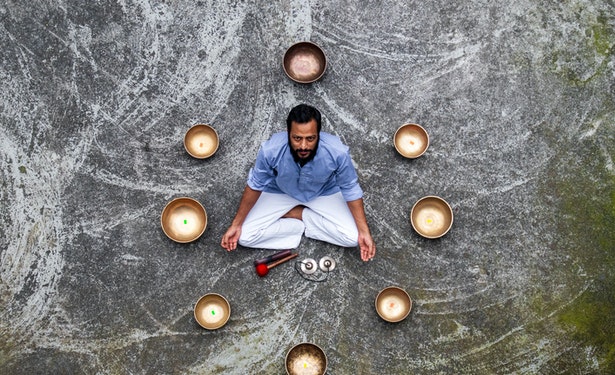Managing depression with the help of meditation
People have been practising meditation for thousands of years, and it is one of most well researched and proven methods for reducing stress and depression.
Medically reviewed by Dr. John Ogrodniczuk, PhD – Written by Chloe Sernasie and the HeadsUpGuys Team
Posted January 21, 2021. Updated November 3, 2021.
Research shows that meditation is a powerful tool for reducing stress, and can help with depressive symptoms by improving sleep quality and increasing focus.
People have been practising meditation for thousands of years, and it is one of most well researched and proven methods for reducing stress. At its most basic level, meditation is the process of training your brain to redirect your thoughts to focus on the present moment. In doing so, we can effectively “clear our minds”, which has been shown to have a number of physical and mental health benefits. Not only has research shown that it’s effective, but you can do it anywhere and it’s free.1,2
Meditation has been regaining popularity as researchers and the public have caught on to the many benefits of maintaining a regular meditation practice. A number of celebrities, CEOs, and athletes have been outspoken about the role that meditation plays in their lives. The late NBA legend Kobe Bryant kept a steady practice, stating in an interview, “I meditate every day and I usually do it for ten or fifteen minutes in the morning, as that prepares me to face whatever comes next.”3
More and more men are getting into meditation to better control their thoughts and eliminate mental strain. Here are some steps to help get you started:
Step one: Understand the Benefits of Meditation
Mitigates negative thinking
- A key tenet of meditation is learning to accept and let go of thoughts, without becoming attached to them. Negative and intrusive thoughts are a normal experience, but when you’re depressed, they can become more intense and frequent. By learning to cope with negative thoughts in a healthy way, meditation enables us to recognize that thoughts are temporary and become less affected by them.
Reduces Stress
- By lowering levels of the stress hormone cortisol in the brain, meditation allows your mind and body to feel at ease.4 Meditation training has even been implemented in the US military for this purpose. One study has shown that meditation has the potential to enhance cognition, even under periods of high stress, such as combat.5
Brings your mind to the present
- By focusing your thoughts on the present moment, meditation prevents you from ruminating on depressive thoughts or worrying about an uncertain future. Research suggests that excessive mind-wandering is associated with depression and a variety of other mental health issues, however, this tendency towards mind-wandering can be reversed through meditation, improving attention and awareness of the present.6
Fights insomnia and improves sleep
- Sleep issues are a common symptom of depression. Meditation can increase your body’s production of melatonin and reduce your heart rate, mimicking the physiological changes that occur in the early stages of sleep7, so that you can get to bed quicker. Meditation also increases your body’s control of the autonomic nervous system (which regulates a host of bodily functions), making you less easily awakened, so that once you fall asleep, you can better stay asleep.
Step Two: Make a commitment
As with any new regimen, you can’t expect results to happen overnight. Meditation, much like hitting the gym, is most effective when done consistently.
Here’s a list of strategies for incorporating meditation into your life:
Make time for meditation
- Set aside a small block of time in the morning or evening reserved for meditation. You may need to test out some different times and see what gives you the most benefits.
Pick a space to meditate
- It doesn’t have to be anything complicated, the foot of your bed or your living room floor will work just fine. Try to avoid places that you associate with work or stress, such as a home office, and stick to the same place every day.
Share the experience
- Tell a friend you’re going to try meditating so you have someone to hold you accountable. Or, if they’re also interested, you could even set up a challenge with them to both meditate each day.
Challenge yourself
- Habits take time to form, so start strong by challenging yourself to meditate every day for three weeks.
Practice, practice, practice
- Meditation is like any other new skill, you won’t become a pro overnight, and it can be challenging at first. Like weightlifting, you may want to start small (five minutes per day is great) and work your way up to longer meditations as you strengthen your “brain muscle”.
- What’s most important is that you’re consistent: you will reap more benefits from meditating for ten minutes per day for a week than you will from doing one, long sixty-minute meditation.
Step Three: Start Practicing
Understand the types of meditation and build your practice around forms of meditation that appeal to you.
Common elements of meditation include: relaxed breathing, a comfortable sitting position, a quiet location, and focused attention.
All the forms below can be guided or unguided. Guided meditation involves following a verbal prompt that guides you through various actions throughout your meditation, whereas unguided meditation consists of sitting or laying in silence and utilizing the components of meditation to meditate on your own.
We recommend starting with guided meditation to familiarize yourself with the practice. There are plenty of great guided meditations on YouTube and Spotify. Or try an app, like HeadsSpace or Calm, which is endorsed by NBA superstar LeBron James.
Here’s an overview of popular ways to meditate:
- Mindfulness meditation
has existed for thousands of years and has its roots in Hindu and Buddhist teachings. The main objective of mindfulness is to relax and calm your mind by focusing on the present moment. To do a basic mindfulness meditation:
1. Find a quiet and comfortable spot to sit down, and then close your eyes. 2. Focus on your breathing, slowly inhaling and exhaling all the way. 3. If your mind begins to wander, notice this without judgement, and simply refocus your attention on your breathing.4. Repeat this process for the allotted time (eg. five minutes). As you improve in your practice, you will sharpen your ability to quiet your mind and take control of your thoughts when they wander off.
- Mantra Meditation
In this form of meditation, people choose a word or phrase to focus on and repeat as they meditate. It is a good option for people who struggle with silence or focusing solely on their breath. The classic mantra used in Mantra meditation is “Om,” which is a sacred spiritual symbol in Indian religions, and “at peace” or “calm” are popular choices in English. However, you can choose any sound, word, or phrase you connect with to be your mantra.
- Metta Meditation
Metta meditation is a traditional Buddhist practice that aims to promote kindness and compassion for all living beings. A meta-analysis concluded that it can enhance positive emotions in daily life8, and may even be able to reduce the perception of physical pain.9 To practice Metta meditation, pick a phrase that promotes kindness such as “May I be happy and healthy,” and repeat it to yourself as you meditate. Continue repeating this phrase as you think of other people in your life who you would like to send this message to.
- Visualization
To incorporate visualization into your practice, focus on a scene that brings you peace, such as a sandy beach or your childhood home. Visualize it in as much detail as possible, utilizing all your senses, as you meditate. You may also visualize yourself reaching specific goals, which can improve your sense of motivation.
- Progressive Muscle Relaxation
Progressive muscle relaxation focuses your attention on your body and areas of tension in order to slowly relax each muscle. To practice, focus on different areas of your body, and pay attention to how they feel. Work your way up from your toes to your head, tensing and relaxing them one muscle group or body part at a time.
- Movement Meditation
Movement meditation is great for people who have difficulty sitting still but who want to have a regular meditation practice. It exists in many established forms, including Yoga, Tai Chi, and Qigong, but can also be as simple as a mindful nature walk. Even something like picking up a basketball and repeatedly practising your shot can be a mediation if you get lost in the focus of it and stop thinking about anything else.
Content source: https://headsupguys.org/managing-depression-help-meditation/

